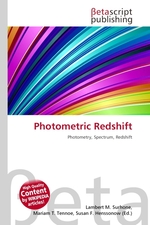Photometric Redshift
Lambert M. Surhone, Miriam T. Timpledon, Susan F. Marseken
бумажная книга
High Quality Content by WIKIPEDIA articles! A photometric redshift is an estimate for the distance of an astronomical object, such as a galaxy or quasar. The technique uses photometry (that is, the brightness of the object viewed through various standard filters, each of which lets through a relatively broad spectrum of colours, such as red light, green light, or blue light) to determine the redshift, and hence, through Hubble's law, the distance, of the observed object. The technique relies upon the spectrum of radiation being emitted by the object having strong features that can be detected by the relatively crude filters. The technique was developed in the 1960s, but was largely replaced in the 1970s and 1980s by spectroscopic redshifts, using spectroscopy to observe the frequency (or wavelength) of characteristic spectral lines to see how far the lines were shifted from their usual position. The technique has come back into vogue as a result of large sky surveys conducted in the late 1990s and early 2000s which have detected a large number of high-redshift objects.
Данное издание не является оригинальным. Книга печатается по технологии принт-он-деманд после получения заказа.


